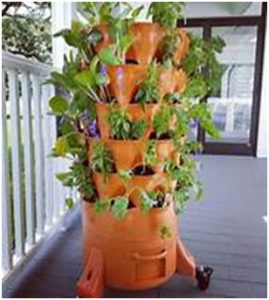By Emmy Ulmschneider
and Debbie Roland
Master Gardeners
We have touched on garden towers in our container gardening article but wanted to give you more detail on this sustainable way of growing vegetables, herbs and flowers. As developers build homes closer together with smaller yards, one of these towers should be on every new homeowner list of purchases. To see what we wrote previously, check out that article: tinyurl.com/56behex2
Of the five types of containers or raised bed gardens in my yard (Debbie’s yard), the garden tower is quickly becoming my favorite. So, with that experience let’s see what we learned.
A definite pro is that it takes about five square feet to successfully grow your crops vertically, so even a small yard can accommodate one.

The tower I (Debbie) have will grow 50 plants at one time. The bins stack around a central container which is a perforated tube where you toss all your kitchen scraps which will eventually become compost. Fill the tower with potting soil, add seeds or seedlings and a few composting worms in the compost tube. The top bin is open. When you water the water runs through the potting soil and the composting kitchen waste into a drawer which holds the liquid at the base of the tower. There is a screen that keeps the scraps from dropping into the drawer. The drawer slides out and you pour the water back into the top growing container thereby reusing the water that now contains the nutrients from the compost process and what was washed out of the potting soil.
Decide on a location before you fill it as it gets too heavy to move. Mine sits on the back porch that gets full sun until about 2 p.m. In hindsight I wish I had put it where it gets a little more shade. “Full sun” really means six to eight hours and in West Texas that is only about half of the time the sun shines on our yards. The top part above the drawer rotates so I can monitor the amount of sun the plants receive.
Before you buy, do your homework. Consider the space, the durability of the tower, the location of your water source and where the sun hits your yard. Think about what you want to grow. Some brands are taller than others and some have larger growing holes. Think about how you garden; even if you need to sit to garden, there is a tower for you! Not into composting? No problem, not all towers have a composting tube.
The tower I bought was expensive, but it was well made, well thought out, grows a variety of plants, makes compost and will last a long time.
For more information, call the AgriLife office at 498-4071 in Odessa or at 686-4700 in Midland or visit aggie-horticulture.tamu.edu or westtexasgardening.org.




